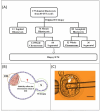Assessing the Viability of Segmental Aneuploid Embryos: A Chromosomal Concordance Study of 175 Human Blastocysts
- PMID: 40508090
- PMCID: PMC12155557
- DOI: 10.3390/ijms26115284
Assessing the Viability of Segmental Aneuploid Embryos: A Chromosomal Concordance Study of 175 Human Blastocysts
Abstract
Preimplantation genetic testing for aneuploidy (PGT-A) is widely used to select euploid embryos for in vitro fertilization (IVF), but its accuracy in predicting the implantation potential for full segmental aneuploid (Seg-A) embryos remains unclear. In this study, we investigated chromosomal concordance between clinically biopsied trophectoderm (TE) and inner cell mass (ICM) in 175 donated blastocysts, which comprised those clinically diagnosed as euploid (13), Seg-A (36), segmental mosaicism (Seg-M) (60), whole-chromosome aneuploid (Who-A) (52), and whole-chromosome mosaicism (14). Using next-generation sequencing (NGS), we found that TE-ICM concordance rates were higher for euploid (85%) and Who-A (94%) embryos but significantly lower for Seg-A (25%) and Seg-M embryos (33%). For Seg-A, the euploidy rate in the ICM was 19% and the euploidy rate in the ICM was 63% for Seg-M. These low concordance rates may be due to technical and biological artifacts of PGT-A for Seg-A. Despite the significant discordance between TE and ICM, a subset of Seg-A embryos demonstrated euploidy. While clinically diagnosed euploid embryos remain the preferred choice, Seg-A embryos should be considered as having implantation potential. In particular, Seg-A results should be clearly distinguished from Who-A results and not routinely categorically discarded. Further research is required to refine the selection criteria, aided by parental karyotyping or re-biopsy, and to develop more reliable embryo assessment methods to ensure the accurate evaluation of reproductive potential and support shared decision making between doctors and patients.
Keywords: preimplantation genetic testing for aneuploidy (PGT-A); segmental aneuploidy (Seg-A); segmental mosaicism (Seg-M); trophectoderm (TE) biopsy.
Conflict of interest statement
The authors declare no conflicts of interest.
Figures



References
MeSH terms
Grants and funding
LinkOut - more resources
Full Text Sources

